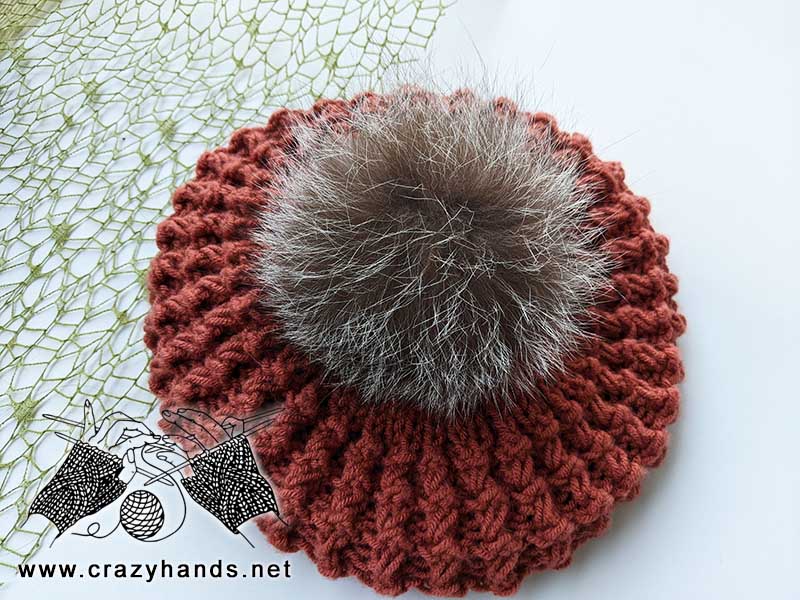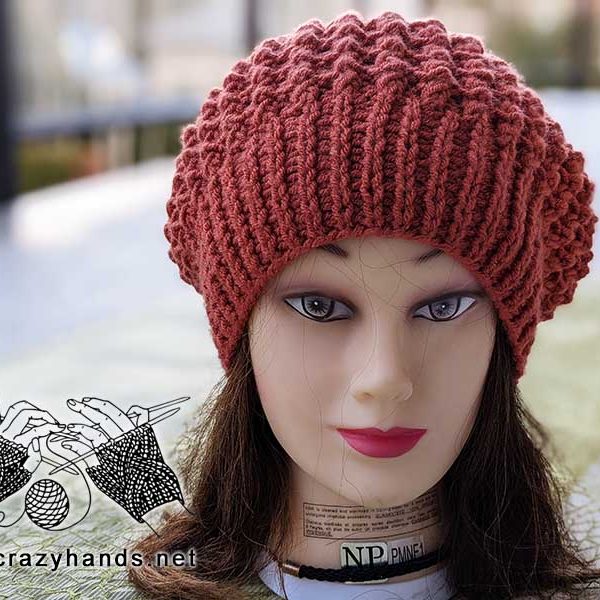Contents
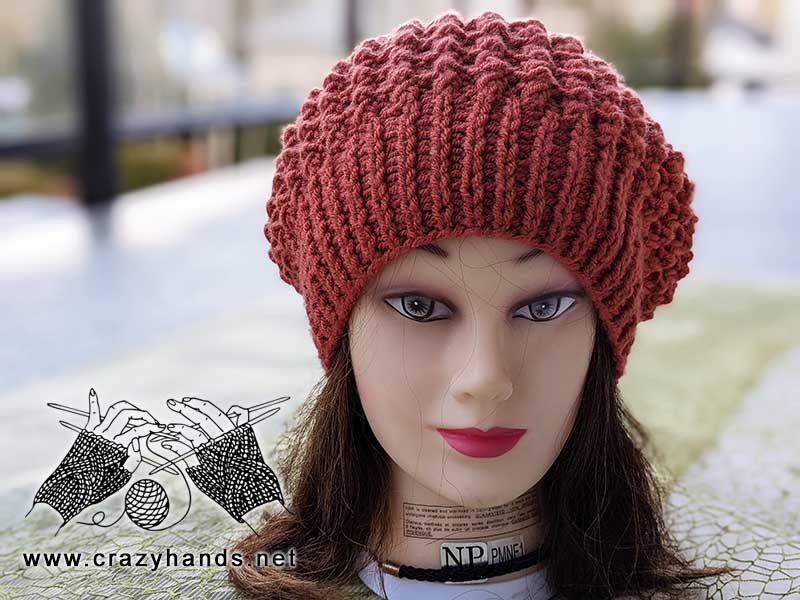
Knitting materials and tools:
Circular (or straight) knitting needles: 4 mm (US 6/UK 8) – for the ribbing and the crown, 4.5 mm (US 7/UK 7) – for the body part. If your head circumference is 53-54 cm you may use 3.5 mm (US 4) for the ribbing.
Craft Smart, Value –100% acrylic, 198 grams -324 m per skein.
Weight Category – 4. Quantity – 99 grams.
Flat knit beret hat size:
Head circumference: Teen/Adult: 54-58 cm (21-23”)
Gauge: 18-19 stitches = 4 inches in stockinette
Common abbreviations of knitting stitches:
k – knit
kb – knit through the back loop
sel s – selvage stitch: always slip the first stitch knitwise, work to the last stitch, purl the last stitch
RS – right side
Inc – knit the next stitch through the front loop (do not slide the stitch off the left-hand needle), then knit the same stitch through the back loop and slide original stitch off the left-hand needle.
Yo – yarn over
k2tog – knit two together
k2togB – knit two together through the back loop
p – purl
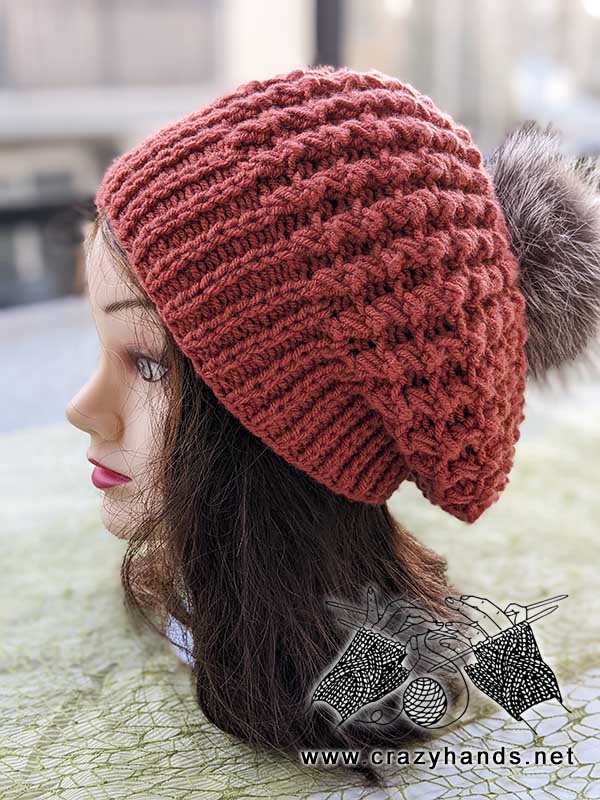
Flat knit beret hat pattern:
Using smaller size needles, cast on 85 stitches.
Row 1: sel s, *p1, k1 – repeat from * till the end, p1, sel s.
Row 2 (RS): sel s, *slip next knit stitch purlwise to the right-hand needle holding working yarn in back, p1 – repeat from * till the end, slip next knit stitch purlwise to the right-hand needle holding working yarn in back, sel s.
Repeat Rows 1 and 2 until ribbing reaches 7 cm.
In the next Row we are going to add 20 stitches to get in total 105 stitches. The final number must be multiple of 3, plus 1 extra stitch and plus 2 selvage stitches.
Row 1: sel s, [p1, k1, p1, inc] – repeat 20 times, p1, k1, p1, sel s.
Change to bigger size knitting needles.
Row 2 (RS): sel s, [p1, skip next two stiches, insert the tip of the right-hand needle between 2nd and 3rd stitch and draw up a long loop, yo, k2tog] – repeat till the end, p1, sel s. You can knit k2tog stitch through the back loops if it is easier for you.
Row 3: sel s, [k1, p1, slip the next two stitches holding working yarn in front] – repeat till the ends, k1, sel s.
Row 4: sel s, [p1, k2togB, k1] – repeat till the end, p1, sel s.
Row 5: sel s, [k1, skip next stich, insert the tip of the right-hand needle between 1st and 2nd stitch and draw up a long loop, k2togB] – repeat till the end, k1, sel s.
Repeat Rows 2-5 until the body part reaches 12 cm. After the ribbing I have done in total 24 rows.
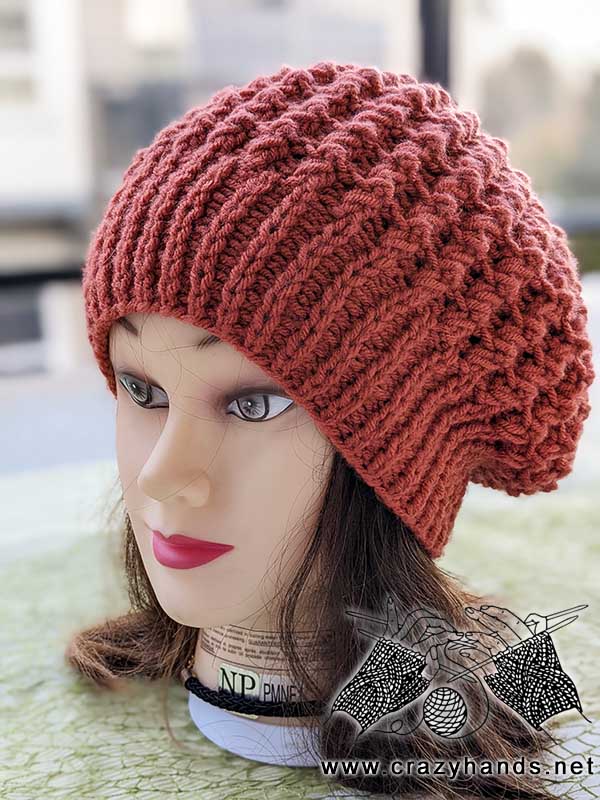
Shaping the crown of flat knit beret:
Change to smaller size knitting needles (optionally).
Row 1: sel s, [p1, k2togB, p1, kb2] – repeat till the end, p1, sel s.
Row 2: sel s, [k1, p2, k1, p1] – repeat till the end, k1, sel s.
Row 3: sel s, [p1, k1, p1, k2] – repeat till the end, p1, sel s.
Row 4: Repeat Row 2.
Row 5: Repeat Row 3.
Row 6: Repeat Row 2.
Row 7: sel s, [p1, k1, p1, k2tog] – repeat till the end, p1, sel s.
Row 8: sel s, [k1, p1] – repeat till the end, k1, sel s.
Row 9: sel s, [p1, k1] – repeat till the end, p1, sel s.
Row 10: Repeat Rpw 8.
Row 11: k2tog – till the end. Purl together the last stitch and the selvage stitch.
Row 12: sel s, purl all stitches, sel s.
Row 13: sel s, k2tog till the ends, sel s.
Cut the yarn leaving 40 cm tail. Use hook or tapestry needle to pull yarn tail through the remaining stitches. Pull tight to close the crown. We will seam beret on the right side using a mattress stitch. Make sure to line up your sides correctly. You can use locking stitch markers to pin sides of your beret in place in order not to end up with lopsided seam. Go underneath the first 2 little bars between 2 selvage stitches on the right side (you can start seaming on either side), after
that go underneath the first 2 little bars between 2 selvage stitches on the left side. *Draw the yarn through the next 2 bars on the right side, draw the yarn through the next two bars on the left side. Repeat from * and tug on the yarn every couple of stitches. Do not pull tight. Finish seaming and weave in ends.
